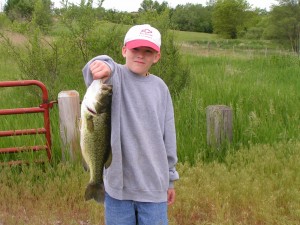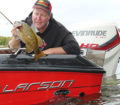
With all of mankind’s scientific research that has gone into fishing technology and lure development over the last 100 centuries, Heath Hackett of Kingsley caught this 20” long bass last summer on what else? A worm and a bobber!
By Some Guy:
The art of fishing, or angling, came into existence when the first caveman probably looked into a stream, saw a fish and said to his self, “I can eat that thing! How do I get it out of there?” This early man just jumped in the water and used his hands to catch the fish. Since this early angling technique humans have been improving ways to capture fish for the purpose of providing a source of food and recreation for centuries.
The earliest tools used by fisherman were spears. Prehistoric humans would craft their fish spears out of wood or animal bones. They would stand by the water, wait for a fish to swim by, and then stab it. This method had more of a success rate than “hand fishing.” Spear fishing is still used in certain areas by modern man.
When man discovered the art of weaving and basket making, the use of fishing nets evolved. Early weaving dates back to about 8000 to 9000 B.C. The early fish nets were made of plant fibers, animal sinews or animal skins. At around this time, anglers also started using fish traps. A fish trap has a cavity that a fish can swim into but can’t swim out of. When the trap is pulled out of the water, you have the fish. Today’s commercial fishermen still use nets to capture fish. In almost all circumstances, fish traps are illegal.
Another one of man’s earliest known tools was the gorge. This was the predecessor of the modern fish hook. A gorge was an object about an inch long and pointed on both ends. They were made from wood, bone or stone. The gorge was tied in the middle by a line and covered with some form of bait. When the fish swallowed the bait, the line could be pulled tight and the gorge would wedge sideways in the fish’s gullet. With the coming of the Iron Age, sometime around 800 B.C., man started making fish hooks out of metal.
It is not known when angling with a rod as we know it today started. A Chinese account of about 4000 B.C. refers to fishing with a line spun of silk and a bamboo rod. Early Egyptian drawings, dating to about 2000 B.C., show an angler with a fishing rod and a net. Very early fishing rods had no eyes or reels. The line was simply tied to the end of a stick. The method of fishing was probably dapping. This is technique of gently laying the bait on the surface of the water and waiting for something to eat it.
There were no major advancements in fishing equipment for thousands of years. The next great advancements in fishing technology began about 1650 A.D. This is about the time that anglers started to attach wire loops to the ends of their rods for the line to pass through. These early “eyes” allowed the angler to have a running line. This was useful for both casting and playing a hooked fish.
With the invention of fishing rod eyes, anglers could use much longer lines. A device was needed to take up the line that was not in use to keep it from tangling. The fishing reel was invented. Early fishing reels consisted of a wooden spool with a metal ring that fit over the anglers thumb. The thumb was used to turn the reel. Evolution of the reel continues to this day.
It was at this time in history that great advancements in rods also took place. Heavy native woods were replaced with straight-grained and elastic woods like lancewood and greenheart from South America. Steel rods replaced these woods, and in turn were replaced by fiberglass. Modern rods are mostly carbon fiber composition.
When fishing with a hook anglers must select what to use for bait. Ancient man baited his gorge with much the same things as modern man. That is anything that a fish would naturally eat in that area; worms, maggots of certain flies, the flies themselves and small fish to name a few. A couple of problems with natural bait are that one must first catch his bait before he could catch the fish, then the fish must be hungry. If the natural food was unavailable for use as bait, early anglers would use some other source of “natural” food. This included such items as bread paste, cheese and scraps of meat.
Artificial lures were designed to take the place of natural bait in fishing. They are used when an angler can not procure something “natural” for the fish to eat. The earliest evidence of artificial lures came in Roman writings during the 2nd or 3rd century A.D. Macedonians at the time were reported to have been tying artificial flies for trout fishing. Lure technology did not have any advancement until the late 15th century. At this time books were being published in England on how to make artificial flies and lures. Early lures were made out of wood and painted to make them look like something a fish wood like to eat. Modern day artificial lure are made of plastics.
Today’s modern fishing tackle manufacturers spend a great deal of time and money to engineer and market artificial lures. The lures are painted to look exactly like natural foods. They are also engineered to imitate the swim patterns of natural foods when the angler reels in the lure. Some lures are designed to create strikes by fish even if the fish isn’t hungry. The actions of these lures is either supposed to make the fish strike in anger, or the lures motion is so irresistible that fish cannot help but strike it.
Tackle companies have also engineered alternatives to natural baits. Modern catfish bait is designed so that the scent of it will carry further in the water and last longer than the natural foods of catfish. Scents are on the market to spray onto plastic lures to make them smell like “real” bait as well as looking like it. The newest trend in fishing technology is the addition of the scents right into the artificial lure. These new scented baits are advertised as being scientifically engineered to out-perform natural baits.
With modern science on the side of the angler, fish just don’t have a chance any more. Right!















